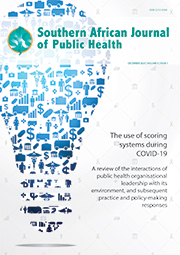Articles

Measuring social and behaviour change communication capacity in Malawi
Abstract
Background. In the context of the burden of disease and the need to promote health among the Malawian population, Health Communication for Life in 2016 embarked on a 5-year social and behaviour change communication (SBCC) project to support the Malawian government’s effort to expand access to sustainable health services. As part of this support, a capacity assessment was conducted in the Ministry of Health.
Objectives. To obtain a baseline measurement of current SBCC competencies, and to inform skills building for SBCC.
Methods. Two standardised participatory tools were developed to capture SBCC competencies at the national and zonal/district levels, based on a collective competency framework. The national assessment was conducted with 8 health promotion officers based in the Health Education Section of the Ministry of Health. At district level, 30 district health promotion officers from 28 districts participated in the assessment.
Results. The capacity assessment showed that health promotion officers had on average low capacity to plan, implement and evaluate SBCC interventions. However, there was variation within different domains, where the institutional capacity to lead and co-ordinate at both national and district levels was fairly strong, yet organisational capacity to evaluate, scale and sustain SBCC interventions was relatively weak. Participants also provided input to improve the assessment tools.
Conclusion. By presenting the process and results of the capacity assessments, this article highlights the need for articulating SBCC requisite skills, and establishing a baseline measurement of these skills as a step towards strengthening SBCC capacity at different levels of government.
Authors' affiliations
M Jana, Department of Political Studies, School of Social Sciences, University of the Witwatersrand, Johannesburg, South Africa
S Nieuwoudt, Health and Society Division, School of Public Health, Faculty of Health Sciences, University of the Witwatersrand, Johannesburg, South Africa
W Kumwenda, FHI 360, Capacity Building, Lilongwe, Malawi
A Chitsime, Health and Society Division, School of Public Health, Faculty of Health Sciences, University of the Witwatersrand, Johannesburg, South Africa
R Weiner, Health and Society Division, School of Public Health, Faculty of Health Sciences, University of the Witwatersrand, Johannesburg, South Africa
N Christofides, Health and Society Division, School of Public Health, Faculty of Health Sciences, University of the Witwatersrand, Johannesburg, South Africa
Full Text
Cite this article
Article History
Date published: 2018-09-14
Article Views
Full text views: 1432

.jpg)


Comments on this article
*Read our policy for posting comments here-
Best file recovery software to recover deleted files or lost data
-
thank you
-
obati ejakulasi dini dengan ini
-
Obat Kesuburan Paling Manjur
-
thank you
-
good
View all commentsby nana wang (2018-11-08)
"Mr Cho Thuê Lao Động 24h" (2018-11-19)
by sinta aprilia (2018-11-30)
by sinta aprilia (2018-12-18)
by christhanah 1 (2019-01-04)
"Rent the cheapest 4-seater car rental in Hanoi at Van Hai" (2019-01-16)